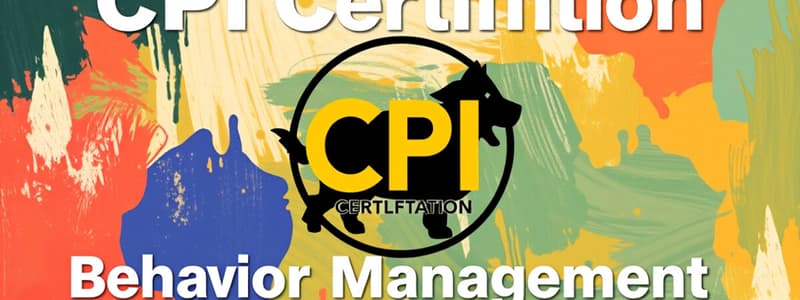Podcast
Questions and Answers
What are the 4 Behavior Levels?
What are the 4 Behavior Levels?
- Defensive (correct)
- Anxiety (correct)
- Acting Out Person (correct)
- Tension Reduction (correct)
What should staff attitude and approach be to anxiety?
What should staff attitude and approach be to anxiety?
Be Supportive
What is the staff attitude and approach to Defensive behavior?
What is the staff attitude and approach to Defensive behavior?
Directive
What is the staff attitude and approach to an Acting Out Person?
What is the staff attitude and approach to an Acting Out Person?
What are the staff attitudes for Tension Reduction?
What are the staff attitudes for Tension Reduction?
What is integrated experience?
What is integrated experience?
What is non-verbal proxemics?
What is non-verbal proxemics?
What is kinesics?
What is kinesics?
What are the 3 reasons for using the CPI supportive stance?
What are the 3 reasons for using the CPI supportive stance?
What are the components of the communication pyramid?
What are the components of the communication pyramid?
What is paraverbal communication?
What is paraverbal communication?
What are the three components of paraverbal communication?
What are the three components of paraverbal communication?
What is the verbal escalation continuum?
What is the verbal escalation continuum?
What is questioning?
What is questioning?
What is an intervention for questioning?
What is an intervention for questioning?
What is refusal?
What is refusal?
What is an intervention for refusal?
What is an intervention for refusal?
What is release?
What is release?
What is an intervention for release?
What is an intervention for release?
What is intimidation?
What is intimidation?
What is an intervention for intimidation?
What is an intervention for intimidation?
What is tension reduction?
What is tension reduction?
What is an intervention for tension reduction?
What is an intervention for tension reduction?
What are the 3 keys to setting limits?
What are the 3 keys to setting limits?
What is empathetic listening?
What is empathetic listening?
What are 5 things to do during active listening?
What are 5 things to do during active listening?
What are precipitating factors?
What are precipitating factors?
What is rational detachment?
What is rational detachment?
What is integrated experience?
What is integrated experience?
What are the 3 unproductive reactions to fear and anxiety?
What are the 3 unproductive reactions to fear and anxiety?
What are the 3 productive responses to fear and anxiety?
What are the 3 productive responses to fear and anxiety?
What is the definition of a strike?
What is the definition of a strike?
What are examples of strikes?
What are examples of strikes?
What is the definition of grab?
What is the definition of grab?
What are examples of grabs?
What are examples of grabs?
What are principles of personal safety regarding strikes? (Name two)
What are principles of personal safety regarding strikes? (Name two)
What are principles of personal safety regarding grabs? (Name two)
What are principles of personal safety regarding grabs? (Name two)
Flashcards are hidden until you start studying
Study Notes
Behavior Levels
- Four key behavior levels: Anxiety, Defensive, Acting Out Person, and Tension Reduction.
Staff Attitude and Approach
- Anxiety: Staff should be supportive and non-judgmental to alleviate anxiety.
- Defensive: Take a directive approach to control situations and set limits.
- Acting Out Person: Utilize non-violent physical crisis intervention.
- Tension Reduction: Foster therapeutic rapport to reduce energy and restore rationality.
Integrated Experience
- Staff behavior sets the tone for whether a situation escalates or de-escalates.
Non-Verbal Communication
- Proxemics: Personal space typically ranges from 1.5 to 3 feet, influenced by culture, height, gender, status, and familiarity.
- Kinesics: Body language, including eye contact and facial expressions, conveys strong non-verbal messages.
Supportive Stance
- Three reasons for using a CPI supportive stance: safety, less threatening demeanor, and respect communication.
Communication Pyramid
- Components include verbal communication, paraverbal communication, and non-verbal communication.
Paraverbal Communication
- Involves how something is said, including tone, volume, and cadence.
Verbal Escalation Continuum
- The stages of escalation: Questioning, Refusal, Release, Intimidation, Tension Reduction.
Interventions for Escalation Stages
- Questioning: Seek rational responses and redirect.
- Refusal: Set limits and offer options.
- Release: Allow the outburst to happen and isolate the situation.
- Intimidation: Take threats seriously, seek help, and document.
- Tension Reduction: Use therapeutic rapport to assist in regaining control.
Setting Limits
- Effective limits should be simple, reasonable, and enforceable.
Active Listening
- Empathetic listening involves active engagement to understand underlying messages.
- Five strategies include: undivided attention, non-judgmental stance, listening for emotions, allowing silence, and restating for clarity.
Precipitating Factors
- Internal or external causes of behavior that staff cannot influence.
Rational Detachment
- Maintaining control over one's emotions and not personalizing a student's behavior.
Integrated Experience (Reiterated)
- Staff attitudes and behaviors influence students, creating a reciprocal relationship.
Responses to Fear and Anxiety
- Unproductive: Freezing, overreacting, inappropriate responses.
- Productive: Increased speed and strength, heightened sensory acuity, decreased reaction time.
Definitions of Physical Behavior
- Strike: Contact between a weapon and a target; examples include kicking, punching, and throwing.
- Grab: Attempt to control or damage a body part; examples include biting, scratching, and hair pulling.
Personal Safety Principles
- Strikes: Strategies include blocking or deflecting and moving the target.
- Grabs: Maintain physiological and psychological advantages.
Studying That Suits You
Use AI to generate personalized quizzes and flashcards to suit your learning preferences.




